Technology has cast a spell over everything under the sun and beyond. Music is no exception. From monophony to polyphony, it has spread its wings wider with intervention of technology. Meet Mysuru’s M.G. Ravishankar, who was a guitar student before the advent of mobile phones, a Recording Artiste when Madras was the only Centre for cinemas of South Indian languages and now, a Guitar Teacher in an era where online learning, music apps and enormous reality shows have taken over the Gurukul methodology. Highly regarded in the orchestra circles and having accompanied on guitar for thousands of shows, Ravishankar has worked as a re-recording artiste for over 150 films in Telugu, a few Kannada films and also as a chord artiste at Mysuru Akashvani.
Star of Mysore caught up with the veteran guitarist who traces his journey from orchestras to recording studios, teaching practices and more. Excerpts:
By B.N. Ramya
Star of Mysore (SOM): What fancied you towards guitar?
M.G. Ravishankar (MGR): Hindi heroes playing guitar drew my attention. After having completed my schooling from K.R. Primary School and Sarada Vilas High School, I joined D. Pharma at JSS College during 1971-72. Then, D. Pharma exams were held in October and results were during November end. So, for next year’s admissions, we had to wait till April. During that gap, I joined guitar classes under Mandolin Rathan. That is when life changed and I was hooked to the string instrument.
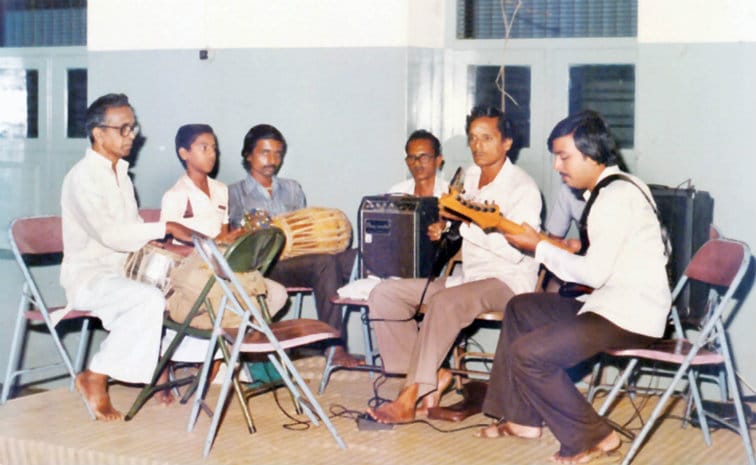
SOM: Tell us about Mandolin Rathan?
MGR: He (Rathan Sir) was the one to introduce Mandolin to Mysuru. But he was also an expert in guitar, flute, mouth- organ and keyboard. Not only did he play these instruments, he also taught them. Rathan never used to let us go without proper practice. Every day for about three-and-a-half years, from 10 am to 2 pm, I used to attend guitar classes and practice rigorously. I became well-versed with Rhythm Guitar. After some time, he had to move to Bengaluru but we met often. He used to take me to weddings where we performed together. ‘Cheluveya andada mogake…’ from the movie ‘Devara Gudi’ was the first song I played for orchestra.
SOM: Your journey as an Orchestra artiste?
MGR: ‘Janakiram and his Orchestra’ was the first orchestra I worked with and ‘Mohan-Kumar Orchestra’ and ‘George and his Orchestra’ were others. I got a chance to work with singers P.B. Sreenivas, Kasturi Shankar, B.K. Sumitra and Prema Rajkumar, actors Dr. Rajkumar and Dr. Vishnuvardhan and drummer Babu Sukumar. I have also played for Ashok-Charan Orchestra in Mangaluru. But it was Kumar of Mohan-Kumar Orchestra who fine-tuned me. He was a mandolin player and had good knowledge of guitar too.
SOM: Who did you emulate?
MGR: I have been around music greats of yesteryears and learnt by observing them. I have learnt from chords, bass and lead guitarists as well. A special mention can be made of Sadananda at Prasad Studio in Madras who played guitar as if he was talking to the instrument and Sebi Dennis, the guitarist at the famous Bollywood Music Director duo Laxmikant-Pyarelal.
Sebi Denis, after he stopped working for Laxmikant-Pyarelal, was employed by Srikantadatta Narasimharaja Wadiyar for the Band that performed at the then Gun House Imperial Restaurant. The Band performed every night and in the morning, practiced at a room on 100 ft. Road. I used to sit outside the room and listen. Gradually I was able to connect with Sebi.
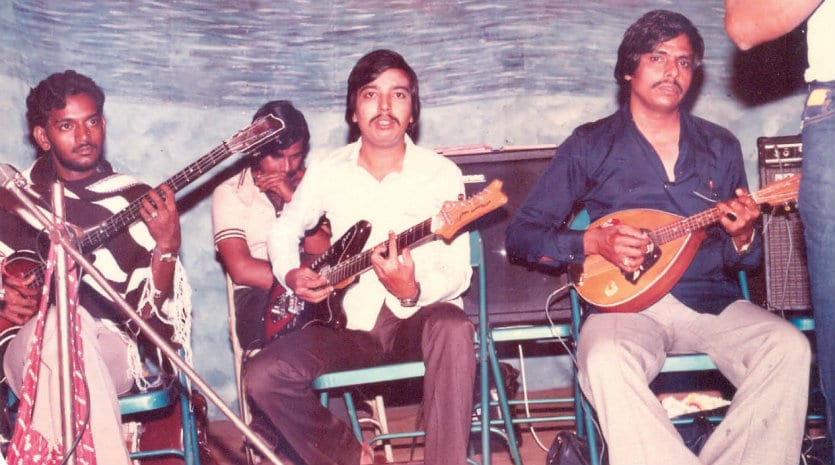
SOM: What took you to Madras?
MGR: Once when I was at guitar class, one Bhupal, a close friend of Music Director Ilayaraja, had come from Madras to meet Mandolin Rathan. Bhupal, who was Rathan’s student, was a Mysurean but had moved to Chennai. He saw me practice and taught me some techniques and also invited me to Madras.
I went to Madras during 1981-82 when I wanted to buy a foreign-made amplifier for my electric guitar. I met Bhupal there and he showed Prasad Studios where Ilayaraja was recording for Tamil movie ‘Rama Lakshmana.’ That was the first recording I got to see. His was a very high standard studio of those days which we would hardly think of even entering into.
Bhupal introduced me to Ilayaraja and Ilayaraja offered me a special coffee. That’s something precious for me. He said: “Learn well and come, I’ll arrange something for you.” It was inspiring enough for me to work hard. Next, I was taken to Vijaya Gardens Studio where Shankar-Ganesh were recording. There used to be five guitars and I used to request for a guitar. Bhupal told Shankar-Ganesh to give me a chance. Shankar gave a strange look at first. Then seeing my interest, I was given a chance to record with them, although much later.
When in orchestra, we used to listen to a song and perform it on stage. We knew only so much but once I went to Madras, I realised music is not just that. Nobody taught us in Studios. I knew basics and I used to observe and learn in the morning and practice at Bhupal’s house late at night. Bhupal was working as a Supervisor at Hindustan Teleprinters. Also there are times when he taught me from 10.45 pm to 4.30 am after his hectic schedules.
SOM: Who are the Music Directors you have worked with?
MGR: I was a recording artiste mostly for Telugu Music Director K. Chakravarthy apart from Shankar-Ganesh, M.S. Viswanathan and composers K.V. Mahadevan, L. Vaidyanathan and Sangeetha Raja (Venkatesh). The Kannada song ‘Baa Bande Kuthko Kuthkonde….’ from the movie ‘Chakravyuha’ (1983), featuring Ambarish and Ambika, was the first song I recorded at Vijaya Gardens under Shankar-Ganesh.
S.M. Jayakumar, the lead guitarist asked me to work for him. But he told that he will not pay me. I instantly agreed because all I wanted was opportunities. So Jayakumar then took me to Music Director M.S. Vishwanathan. Jayakumar used to get many offers and he used to give me some of them. I used to perform and whatever money I got, I gave it to Jayakumar. I used to return to Mysuru and play for orchestras and earn some money for myself. Jayakumar is the father of Music Director Harris Jayaraj of ‘Vaaranam Aayiram’, ‘Ghajini’ and ‘Minnale’-fame.
Till 1992, I was a recording artiste at Vijaya Gardens Studio. I have not played at Prasad Studio but must say I was manufactured at Prasad Studios as I used to go there just to see them work. No one was allowed without permission. I was given a chance because Ilayaraja was a good friend of Bhupal.
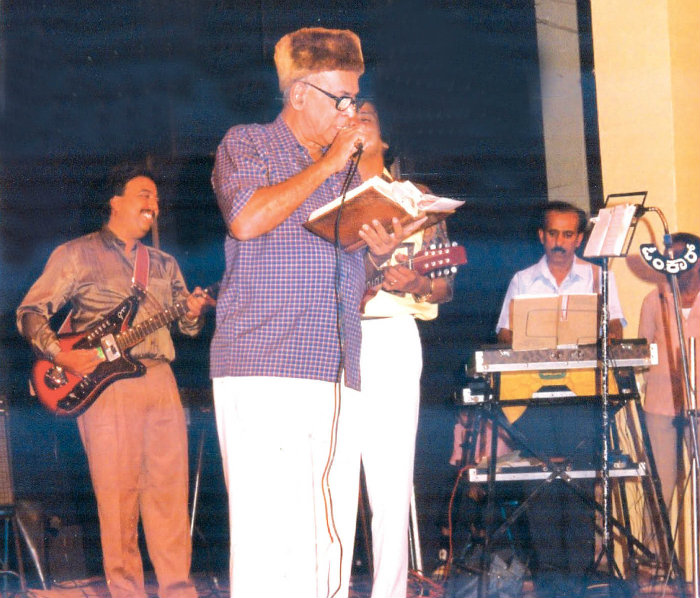
SOM: What was unique in Ilayaraja that caught your attention?
MGR: Most of the Music Directors discouraged new-comers but Ilayaraja was different. Anyone with talent could survive with him. Even a chorus singer was given an opportunity if he or she was up to the mark. For the song ‘Sirivantanaadaru Kannada Naadalle Mereve Bikshukanadaru Kannada Nadalli Madive…,’ C.K. Rama was made to sing with P.B. Sreenivas. That became a huge hit and over 20,000 recording plates were sold. Ilayaraja had the ability to read out chords. After Hindi Music Director Salil Chodhury it was Ilayaraja who was expert in this art. And the other two were M.S. Vishwanathan and his partner Ramamoorthy.
SOM: Difference between recording then and now?
MGR: Music Director was like a Captain. He used to have an arranger. First, raga was composed and then instruments were decided. A minimum of 40 to 60 members were involved in recording a single song — violin section itself had around 20 players. Earlier even for an orchestra, there used to be two to three violinists but now it has become a one-man show. Tuning instruments was completely manual. For example, to tune 100-stringed Santoor, one used to start at 8 am and it would be completed only by afternoon. Now we need to just press a key, thanks to technology.
All instrumentalists and singers had to attend rehearsals and recording on all days no matter how many days it took to record a song. The song ‘Mere sapno ki rani kab aayegi tu’ from Rajesh Khanna’s ‘Aradhana’ was recorded for 21 days with singer Kishore Kumar. Now it’s different, everything is digital. In fact, A.R. Rahman became famous for his digital techniques.
Prasad Studio in Madras was spread across half acres and it had to accommodate all musicians at a time for a recording. Now, even a small studio is enough.
During yesteryears, lyrics were given to the Music Director. He would give tunes in different times (phase) and different raga. Next, the Film Director used to select whichever he wants; then words were set into music. I remember how Rajan-Nagendra struggled to set lyrics to music. Some songs took almost a week to finalise. Now, nobody knows what music is. They just cut, paste and mix.
SOM: So has digitalisation spoiled the essence of music?
MGR: In a way, yes. Live performers lost opportunities. Of course there are positive sides as well. With technology, studio rent is saved. Even without any instrument, recording can be done in no time. Let me tell you an example how a track can be used for re-recording. During 1990-92, I and my friend Praveen Duth Stephen had played music simply at our house and had recorded it.
One day I was watching ‘Mungaru Male’ movie on TV. I knew that Stephen was the arranger for Music Director Mano Murthy for this movie. As I and Stephen had spent time together earlier, I thought let me see how the music has come out. Then I realised that a part of music we had played during 1990-92 at our house was used for this as re-recording.
When I was in Madras during 1983, I had asked Ilayaraja to give me track music of ‘Ilamai Itho Itho…’ from the Tamil movie ‘Sakalakala Vallavan’ to listen which he did without a second thought. During those days, getting track music was not that easy but I have some collections of those days as Ilayaraja was kind enough to tell his Sound Engineer to record it for me.
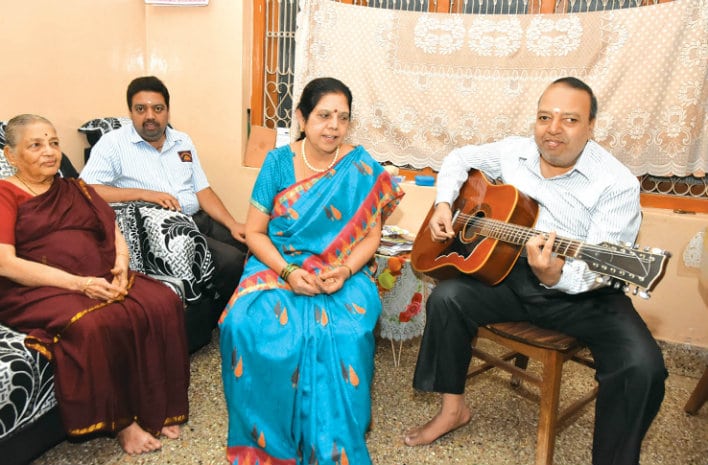
SOM: Do you perform even now?
MGR: There are so many new-comers and a huge generation gap now. I left stage show during the time of P.B. Sreenivas. But, a couple of years back, I did accompany singer Vijay Prakash for his show at Mysore Palace. That too was accidental.
I was invited by drummer Arun Kumar (son of Babu Sukumar) near stage saying he wanted to speak to me so I went there. Vijay Prakash came to me and requested that I play for him. So I did. After that he had even asked me if I can join on their regular shows but I had to deny as I cannot travel now. Other than that, I had accompanied my wife who is a classical singer for Dasara 2019 cultural events. Presently, I have dedicated my time to teach students with a learning instinct — some sent by their music teachers.
SOM: What style do you teach and how different is it from others?
MGR: I teach Guitar in Spanish, Jazz, Western Classical and Indian Classical. Most teachers set a syllabus, teach accordingly and their goal is to see their students pass in exams. But I teach according to the student’s interest. If one comes to me asking for Karnatak, I teach them that and alongside, I teach its difference with Western music and vice-versa. That way, their learning is complete. I have grown up in a Gurukul environment and follow that method even today.
SOM: What is your opinion on today’s teaching practice and online learning?
MGR: Teaching these days has become more of a commercial affair. Of course I too take fees but we must do justice to that. I have seen pamphlets that say ‘Learn guitar in just three months’ when even to hold a guitar properly you need a minimum of 15 days. When this is the case, how can you expect perfection through online learning or music apps.
SOM: Your views on music exams and certificates.
MGR: There was a musical store called ‘Musee Musicals’ in Madras. Above that building, on first floor, they used to conduct the exams of Trinity College London. I too wanted to take up the exam and Bhupal told me to get a basic guitar book to start preparations. I went to Musee Musicals and asked for basic guitar book and they had given me Spanish guitar book. But I didn’t know that and I was using it for Jazz. Then, Bhupal suggested me to approach some retired band masters to help learn notations.
I always got my guitar repaired at a shop on Irwin Road in Mysuru owned by one Sudharma. He was in Karnatak Police Band. I had expressed my desire to learn western guitar. So he introduced me to Naganna Master, a western tenor trumpet player in Police Band, who gave me foundation for western music. Then I went to Madras and passed Spanish guitar 10 grade out of 12 grade exams. Now, I can transpose from Karnatak to Western and Western to Karnatak. I know 64 ragas of Western music.
Here I must share an instance that made me realise mere certificates do not dictate your Vidwat. One of my wife’s students, a native of Tamil Nadu, one day invited us to her sister’s music programme in Mysuru. I asked her sister about her grade in Music — Junior, Senior or Vidwat. She said she had no such credentials and told me: “We see music in different way and you see it in a different way.” But as soon as she started alapana, her immense Vidwat was on display and we were awestruck. That day I realised that we should not judge anyone by just looking at their certificates.
SOM: Your take on reality shows.
MGR: Reality shows are premeditated, they have literally become business. Such show are spoiling kids with over reactions and too much appreciation.
Music is same for everyone. Showcasing sympathetic background of the contestants and seeking support makes no sense to me. With social media, everything gains traction. But during our days, we too have worked hard, sacrificed things and we did it for ourselves, not for others. So no point in highlighting that.
The 2012 winner of ‘Ede Thumbi Haaduvenu’ reality show, Amulya, is my wife’s student. We have seen that child work hard for it even during late in the night.
TV has become ‘Paramadaiva’ (The Supreme God). Children who should play in parks are brought on to the stage. People need to understand not to pressurise children as they have a lot of time to learn and showcase their talent.
SOM: Your advice to youngsters.
MGR: First decide what you want to learn — is it just song or guitar. If you learn songs, again for next song you need a teacher. If you learn guitar, you’ll be able to play any song. Even if you learn a single line, you should learn it perfectly. This is the way I learnt and suggest the youngsters.



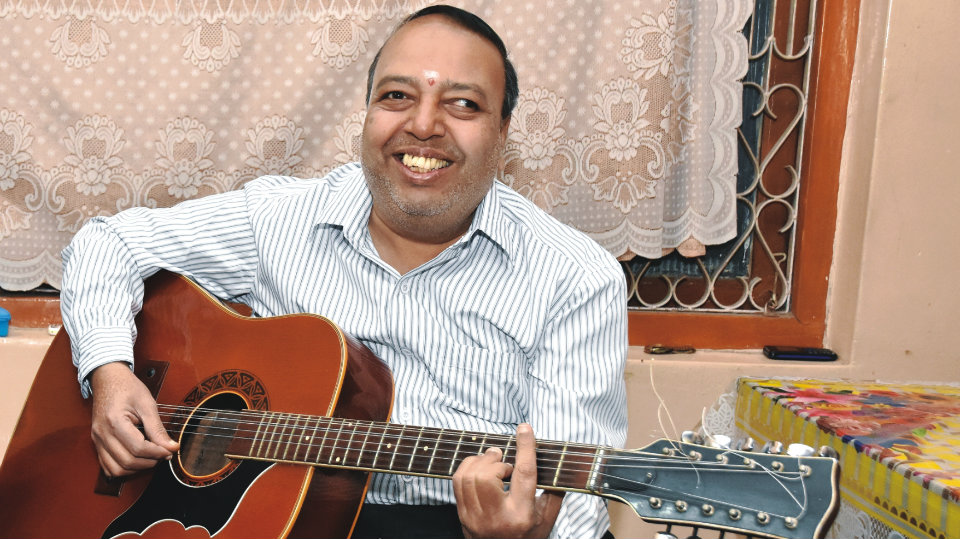
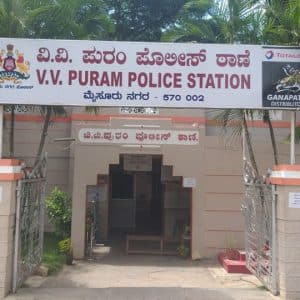
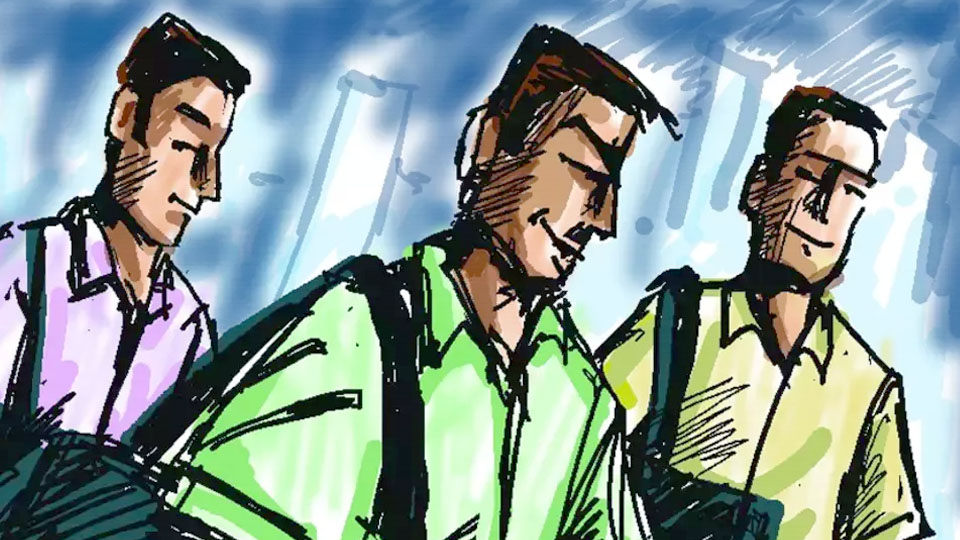
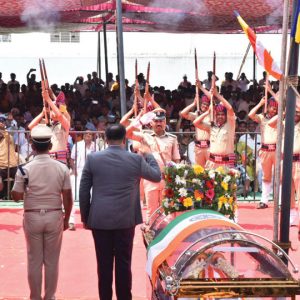
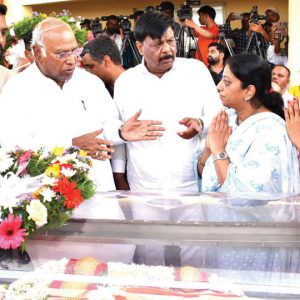
Recent Comments